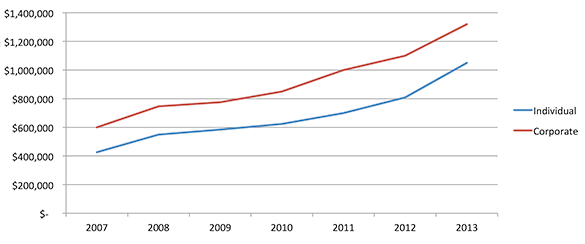- | Corporate Welfare Corporate Welfare
- | Policy Briefs Policy Briefs
- |
Regulation of Platform Markets in Transportation
The development of communication networks along with the rapidly expanding use of smartphones has resulted in unexpected innovations, revolutionizing taxicab and transportation services. Two new firms, Uber and Lyft, offer a particularly novel transportation service by providing car-share and taxi services via cell phone applications and GPS.
The development of communication networks along with the rapidly expanding use of smartphones has resulted in unexpected innovations, revolutionizing taxicab and transportation services. Two new firms, Uber and Lyft, offer a particularly novel transportation service by providing car-share and taxi services via cell phone applications and GPS. Users needing rides simply push buttons on their phones, and within minutes, vehicles arrive at their locations.
This platform market would seem to be a boon to both customers and providers. But, as novel services, Uber and Lyft are competing with established taxicab companies, who resist these newcomers. In cities such as Chicago, Houston, Seattle, and Boston, local taxi companies are suing and submitting regulatory complaints in attempts to shut down these would-be competitors.1
These threatened taxicab firms are spending scarce resources on contesting wealth instead of creating it, or rent-seeking.2 The goal of rent-seeking is to create higher profits by lobbying politicians to impose costly regulatory burdens, such as licensure, safety prescriptions, and price controls, on their new competitors. This is how entrenched interest groups, citing something like public safety, use government to protect their privileges and stifle market innovations.
But even without regulation, firms must maintain good reputations to remain competitive. Government regulation at best duplicates and at worst hinders the role of reputation in encouraging firms to maximize the benefi of their services to their customers. As it currently stands, even a company with an excellent reputation is limited in how fast it can expand its services because of preexisting regulation of transportation services.
Figure 1. Average price of NYC medallions.
Source: NYC Taxi & Limousine Commission, http://www.nyc.gov/html/tlc/html/home/home.shtml.
Traditional taxi regulations restrict entry by requiring a license to legally operate a taxicab. This effectively limits the number of available taxis. The rationale for regulating taxicabs is to protect consumers, yet the regulation’s main result is to keep prices high and actively discourage services to lower-income customers. Platform market transportation services, such as Uber and Lyft, can reverse this trend by maintaining a high quality of service while extending coverage to underserved communities.
WHO REALLY PROFITS FROM CAB SERVICES?
Taxicabs are an integral component of any urban transportation network. In 2013 more than 236 million pas- sengers used taxicabs in New York City, and the average taxi traveled 70,000 miles a year.3 Like many cities, New York heavily regulates taxi companies by restricting the number of potential drivers. The Haas Act of 1937 regulated taxis and limited the number of cab licenses in New York City to 16,900. Despite the population growth of the last 70 years, the number of licenses has actually decreased. In 2004 only 12,187 medallion cabs operated in the city.4
Limiting the supply of medallions allows the taxi cartel to maintain high fares by preventing entrepreneurs from entering the market. Since then, the price of medallions has increased dramatically, as shown in figure 1, above. Indeed, over the last 80 years, taxi medallions have generated anannualized 15.5 percent rate of return.5 Put another way, the value of a medallion doubled, on average, every four and a half years.
The returns for this particular type of rent-seeking are staggering, especially given the fact that these profits come not only from higher fares to consumers, but through worse coverage in poor and minority communities, as we explain below.6 One would think this windfall for cartel operators would trickle down to cab drivers, but this is not the case. As reported by the Washington Post, cab drivers make approximately $30K a year.7 The real winners of licensure are not customers or even cab drivers but the original owners of the medallions,8 who have seen tremendous growth in this asset’s value.9 Put another way, the bulk of the revenue produced by the system is used to pay the up-front costs of procuring new licenses. Under such a system, current operators gain little from increasing total production; in fact, they gain by lowering it.

